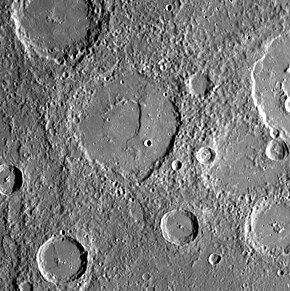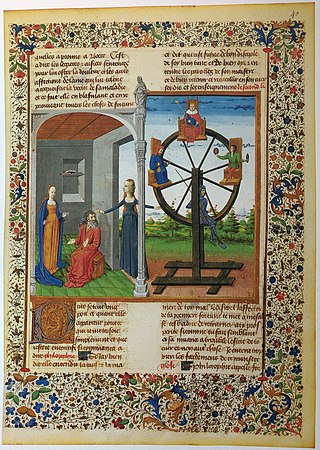
On the Consolation of Philosophy, often titled as The Consolation of Philosophy or simply the Consolation, is a philosophical work by the Roman philosopher Boethius. Written in 523 while he was imprisoned and awaiting execution by the Ostrogothic King Theodoric, it is often described as the last great Western work of the Classical Period. Boethius' Consolation heavily influenced the philosophy of late antiquity, as well as Medieval and early Renaissance Christianity.

Anicius Manlius Severinus Boethius, commonly known simply as Boethius, was a Roman senator, consul, magister officiorum, historian, and philosopher of the Early Middle Ages. He was a central figure in the translation of the Greek classics into Latin, a precursor to the Scholastic movement, and, along with Cassiodorus, one of the two leading Christian scholars of the 6th century. The local cult of Boethius in the Diocese of Pavia was sanctioned by the Sacred Congregation of Rites in 1883, confirming the diocese's custom of honouring him on the 23 October.
Boethius was a Roman philosopher of the early 6th century.

Boethius is a small lunar impact crater located on the east edge of Mare Undarum near the eastern lunar limb. To the southwest is the dark, lava-flooded crater Dubyago.
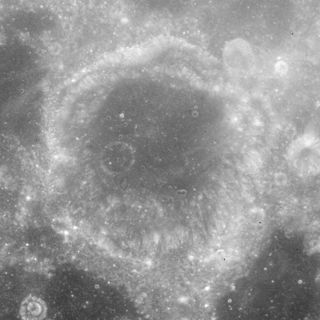
Dubyago is a lunar impact crater that lies in the eastern limb of the Moon. It was named after Russian astronomers Dmitry Dubyago and Alexander Dubyago. It appears significantly foreshortened when viewed from the Earth. It lies along the southern shore of the Mare Undarum, to the southeast of the crater Firmicus.
Boetius de Dacia, OP was a 13th-century Danish philosopher.

Västmanlands-Dala nation, mostly referred to only as V-Dala, is one of the 13 student nations at Uppsala University in Sweden. The nation, intended for students from the provinces of Dalarna and Västmanland – these provinces making up most of the diocese of Västerås – was founded in 1639. The first inspektor of the nation was Olof Rudbeck the Elder, appointed in 1663. The current inspektor is Johan Tysk, professor, Department of Mathematics, Uppsala University.

Koga is an impact crater on Mars, approximately 19 kilometers in diameter. It is located at 29.3°S, 103.8°W, north of the crater Virrat and northeast of the crater Dinorwic. To the north is the crater Nhill. It is named after a town in Tanzania, and its name was approved by the International Astronomical Union in 1991. According to a surface age map of Mars based on US Geological Survey data, the area around Koga is from the Noachian epoch, which places the area's age at 3.8 to 3.5 billion years ago. Sharp blocks and cliffs poke through a mantle of fine material located at the bottom of the crater. At the deepest part of the crater, it is about 5,200 meters in elevation above zero altitude, and its rim averages about 6,400 meters above zero altitude. It is therefore approximately 1.2 kilometers deep.

Sholem Aleichem is a crater on Mercury, named after the Yiddish writer Sholem Aleichem. The inter-crater plain deposits have been deformed by linear ridges.
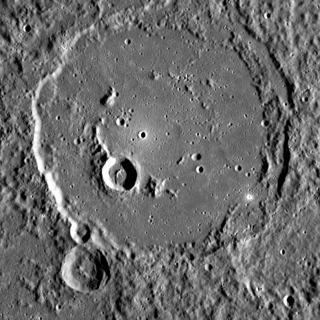
Polygnotus is a crater on Mercury, named by the IAU in 1976, after ancient Greek painter Polygnotus.

Eddie is a crater in the Elysium quadrangle of Mars. It is 89 km in diameter and was named after Lindsay Eddie, a South African astronomer (1845–1913).

Puńsk is an impact crater on Mars, located in the Oxia Palus quadrangle at 20.8° N and 41.2° W. It measures 11.6 kilometers in diameter and was named after the village of Puńsk in Poland.

Dilly is a crater in the Elysium quadrangle of Mars, located at 13.24° North and 202.9° West. It is only 1.3 km in diameter and was named after Dilly, a town in Mali.
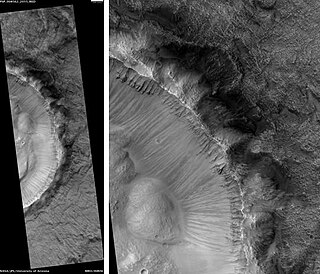
Grindavik is an impact crater in the Oxia Palus quadrangle of Mars, located at 25.39° North and 39.07° West. It is 12 km (7.5 mi) in diameter and was named after Grindavík, a town in Iceland. Impact craters generally have a rim with ejecta around them, in contrast volcanic craters usually do not have a rim or ejecta deposits. As craters get larger they usually have a central peak. The peak is caused by a rebound of the crater floor following the impact.

Events from the year 1800 in Sweden

Etruscan architecture was created between about 900 BC and 27 BC, when the expanding civilization of ancient Rome finally absorbed Etruscan civilization. The Etruscans were considerable builders in stone, wood and other materials of temples, houses, tombs and city walls, as well as bridges and roads. The only structures remaining in quantity in anything like their original condition are tombs and walls, but through archaeology and other sources we have a good deal of information on what once existed.

Baltisk is a crater in the Argyre quadrangle of Mars. It was named after a town in Russia in 1976. Baltisk is located on the western edge of the Argyre impact basin.
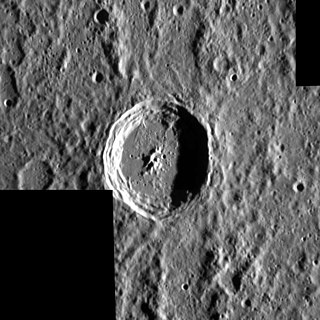
Caruso is a crater on Mercury. Its name was adopted by the International Astronomical Union (IAU) on December 16, 2013. Caruso is named for the Italian singer Enrico Caruso.

Tansen is a crater on Mercury. Its name was adopted by the International Astronomical Union (IAU) in 1976. The crater is named for Tansen, Mughal composer from the court of Akbar.
